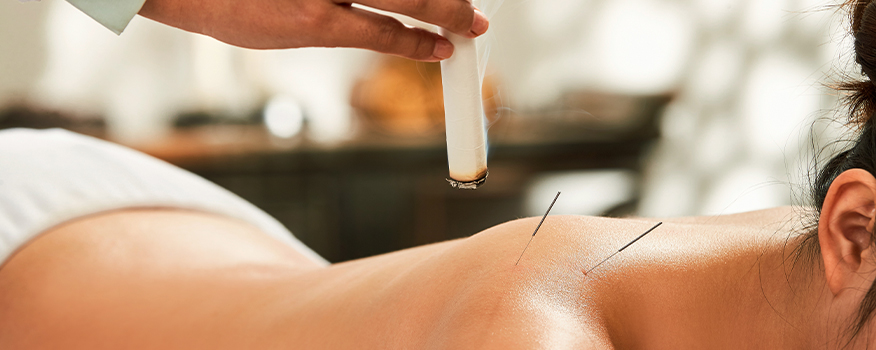Exploring the Ancient Art of Moxibustion in Traditional Chinese Medicine

In the realm of ancient healing practices, Traditional Chinese Medicine (TCM) stands as a testament to the enduring wisdom of millennia-old traditions. Among its many modalities, moxibustion holds a significant place, offering a fascinating insight into the intricate interplay between mind, body, and energy flow.
Moxibustion, often referred to as "moxa," traces its origins back thousands of years in China, where it has been revered as a potent therapeutic technique. Derived from the combination of the Japanese words "mogusa" (meaning mugwort) and "burn" (sustaining combustion), moxibustion involves the burning of mugwort, a herb with purported healing properties, to stimulate specific points on the body.
At the core of moxibustion lies the fundamental principle of TCM – the balance and flow of Qi (pronounced "chee"), the vital energy believed to course through the body along meridians. According to TCM theory, disruptions or blockages in the flow of Qi can lead to various ailments and diseases. Moxibustion aims to restore harmony and promote healing by stimulating the flow of Qi and enhancing the body's innate ability to heal itself.
Practitioners of moxibustion employ various techniques, each tailored to address specific health concerns and individual needs. Direct moxibustion involves placing a small cone or cylinder of moxa directly on the skin at acupuncture points and igniting it, allowing the warmth and therapeutic properties of the herb to penetrate the body. Indirect moxibustion, on the other hand, involves burning moxa on top of acupuncture needles or over specific regions of the body, creating a gentle warmth that penetrates deeply into the tissues.
The benefits attributed to moxibustion are as diverse as the techniques used to administer it. From relieving pain and inflammation to boosting the immune system and improving circulation, moxibustion is believed to offer a myriad of therapeutic effects. It is commonly used to treat conditions such as arthritis, digestive disorders, menstrual irregularities, and respiratory ailments, among others.
Despite its ancient origins, moxibustion continues to garner interest and recognition in modern times, both within and outside the realm of traditional medicine. Scientific research has begun to shed light on the mechanisms underlying its effects, validating its efficacy in certain applications and sparking curiosity in others.
As we delve deeper into the realm of traditional healing practices, moxibustion stands as a timeless reminder of the profound connection between humanity and the natural world. Rooted in ancient wisdom yet evolving with the tide of modernity, it serves as a testament to the enduring legacy of Traditional Chinese Medicine and the boundless potential of the human body to heal itself.

In the realm of ancient healing practices, Traditional Chinese Medicine (TCM) stands as a testament to the enduring wisdom of millennia-old traditions. Among its many modalities, moxibustion holds a significant place, offering a fascinating insight into the intricate interplay between mind, body, and energy flow.
Moxibustion, often referred to as "moxa," traces its origins back thousands of years in China, where it has been revered as a potent therapeutic technique. Derived from the combination of the Japanese words "mogusa" (meaning mugwort) and "burn" (sustaining combustion), moxibustion involves the burning of mugwort, a herb with purported healing properties, to stimulate specific points on the body.
At the core of moxibustion lies the fundamental principle of TCM – the balance and flow of Qi (pronounced "chee"), the vital energy believed to course through the body along meridians. According to TCM theory, disruptions or blockages in the flow of Qi can lead to various ailments and diseases. Moxibustion aims to restore harmony and promote healing by stimulating the flow of Qi and enhancing the body's innate ability to heal itself.
Practitioners of moxibustion employ various techniques, each tailored to address specific health concerns and individual needs. Direct moxibustion involves placing a small cone or cylinder of moxa directly on the skin at acupuncture points and igniting it, allowing the warmth and therapeutic properties of the herb to penetrate the body. Indirect moxibustion, on the other hand, involves burning moxa on top of acupuncture needles or over specific regions of the body, creating a gentle warmth that penetrates deeply into the tissues.
The benefits attributed to moxibustion are as diverse as the techniques used to administer it. From relieving pain and inflammation to boosting the immune system and improving circulation, moxibustion is believed to offer a myriad of therapeutic effects. It is commonly used to treat conditions such as arthritis, digestive disorders, menstrual irregularities, and respiratory ailments, among others.
Despite its ancient origins, moxibustion continues to garner interest and recognition in modern times, both within and outside the realm of traditional medicine. Scientific research has begun to shed light on the mechanisms underlying its effects, validating its efficacy in certain applications and sparking curiosity in others.
As we delve deeper into the realm of traditional healing practices, moxibustion stands as a timeless reminder of the profound connection between humanity and the natural world. Rooted in ancient wisdom yet evolving with the tide of modernity, it serves as a testament to the enduring legacy of Traditional Chinese Medicine and the boundless potential of the human body to heal itself.